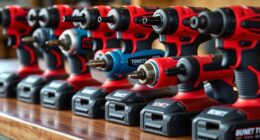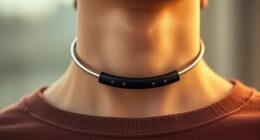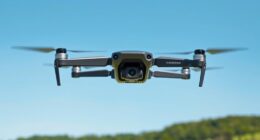To teach deafblind students effectively, use tactile graphics and maps to help them build mental maps through touch, combined with auditory cues for richer understanding. Incorporate vibrational feedback devices to provide immediate environmental alerts and enhance spatial awareness. Develop personalized tactile books and utilize modern technology like braille displays or tactile puzzles for interactive learning. Engaging in multisensory activities fosters independence. Continue exploring these innovative methods to create more inclusive and engaging learning experiences.
Key Takeaways
- Implement tactile graphics and maps with clear textures to help students build spatial awareness through touch.
- Use vibrational feedback devices to provide real-time environmental alerts and enhance sensory perception.
- Develop personalized tactile books combining tactile textures with auditory cues to deepen engagement and understanding.
- Incorporate modern tactile technology, such as braille apps and tactile puzzles, for interactive and multisensory learning.
- Promote multi-sensory activities that integrate tactile, auditory, and visual cues to foster inclusive and effective education.
Utilizing Tactile Graphics and Maps for Spatial Awareness
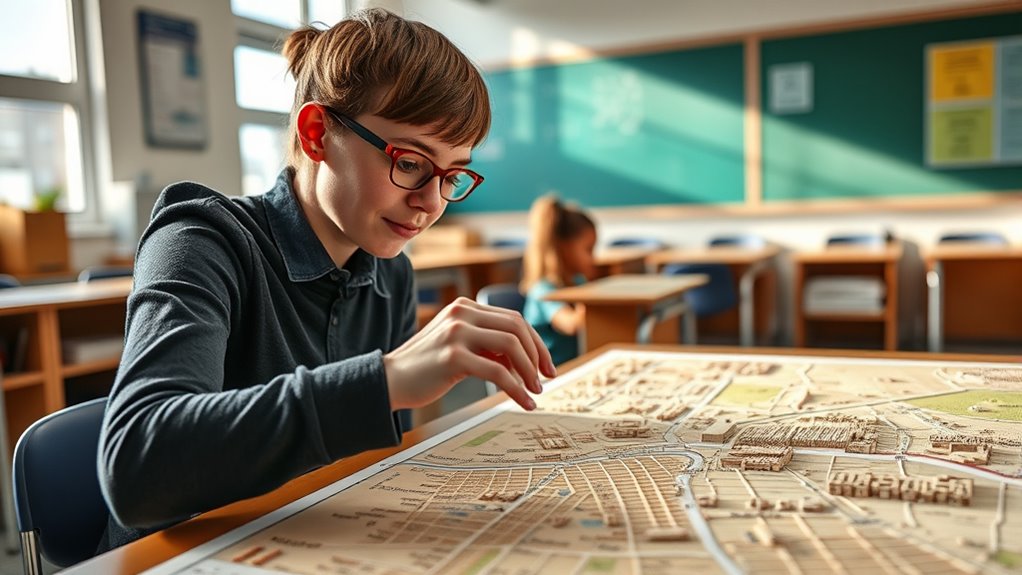
Tactile graphics and maps are essential tools that help DeafBlind students develop a sense of their environment. These tools enhance braille literacy by providing physical representations of spaces, allowing students to explore layouts and features through touch. They also support the integration of auditory cues, which can be paired with tactile information to create a richer understanding of surroundings. When you design tactile maps, consider clear textures and raised symbols that differentiate landmarks, pathways, and obstacles. This visual-tactile combination encourages students to build mental maps and navigate independently. By engaging both tactile exploration and auditory cues, you help students strengthen their spatial awareness, boosting confidence and promoting greater autonomy in unfamiliar environments. Utilizing tactile solutions can further optimize learning experiences by making environments more accessible and navigable.
Incorporating Vibrational Feedback Devices to Enhance Sensory Input
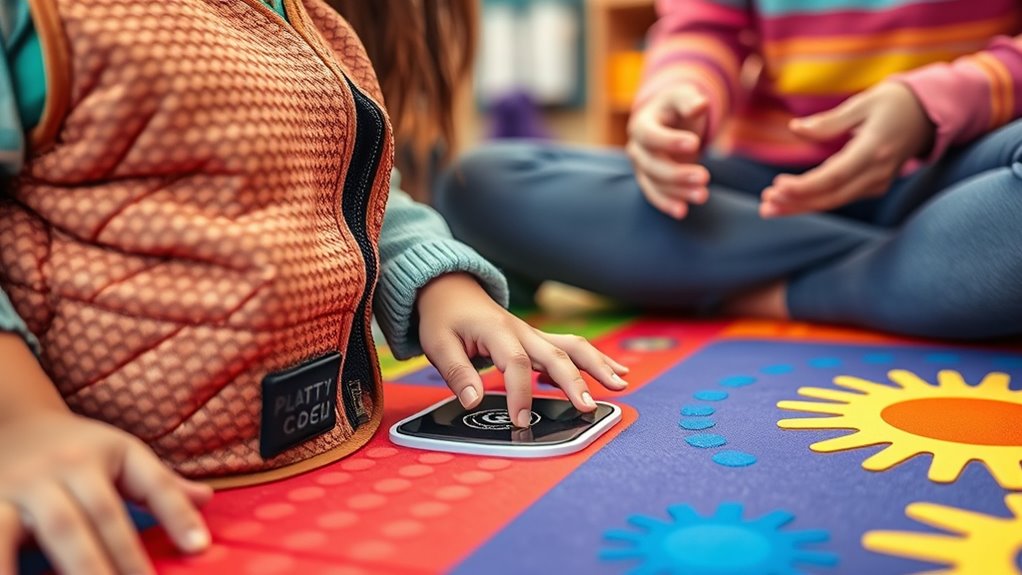
Incorporating vibrational feedback devices into the learning environment can substantially enhance sensory input for DeafBlind students. These devices provide haptic feedback that augments sensory perception, allowing students to better interpret environmental cues and learning signals. By integrating tactile vibrations, you create a form of sensory augmentation that supports spatial awareness and communication. The table below highlights key features:
| Device Type | Functionality | Benefits |
|---|---|---|
| Wearables | Real-time alerts | Immediate feedback |
| Handhelds | Interactive prompts | Focused learning |
| Floor Mats | Environmental cues | Enhanced spatial sense |
| Wristbands | Discrete signals | Personal awareness |
| Vibration Pads | Tactile stimulations | Improved sensory input |
Using these devices, you empower students to actively engage with their environment through enhanced haptic feedback, fostering independence and learning. Research shows that integrating such tactile devices can significantly improve the learning experience for DeafBlind students. Additionally, incorporating sensory integration techniques aligned with these devices can further optimize sensory processing and responsiveness. Moreover, ongoing training in body awareness techniques can help educators and students develop greater sensitivity to tactile cues and adapt more effectively to sensory input. To maximize effectiveness, training in somatic therapy techniques can help educators and students develop greater body awareness and adapt more effectively to tactile cues.
Developing Customized Tactile Books and Learning Materials
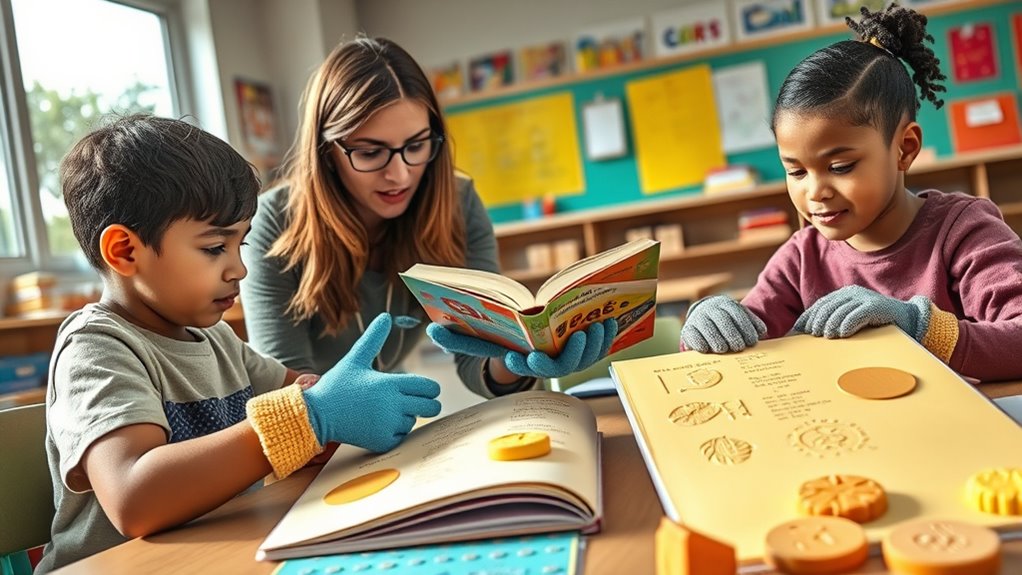
Building on the use of vibrational feedback devices, creating customized tactile books and learning materials offers DeafBlind students a personalized and engaging way to access information. You can incorporate auditory cues into these materials through embedded sound buttons or braille labels that trigger specific sounds, providing context and enhancing understanding. Visual aids, adapted into tactile formats, help students connect tactile sensations with visual concepts, making abstract ideas more concrete. When designing these materials, focus on matching tactile textures with relevant content, ensuring each element reinforces learning. Customization allows you to tailor materials to individual needs, making lessons more meaningful. By integrating auditory cues and tactile visual aids, you create a multisensory experience that supports deeper comprehension and keeps students actively engaged in their learning journey. Additionally, understanding emotional support strategies can help educators address students’ emotional needs, fostering a positive learning environment. Incorporating positive reinforcement techniques can further motivate students and reinforce successful interactions with tactile materials. Implementing secure payment processing methods when sourcing materials online ensures safe transactions for schools and families. Moreover, applying principles of Law of Attraction can help in visualizing and manifesting successful learning outcomes, inspiring both teachers and students to achieve their educational goals. Recognizing the importance of multisensory learning approaches can further enhance the educational experience for DeafBlind students.
Leveraging Modern Tactile Technology and Software Tools

Modern tactile technology and software tools have revolutionized how you create accessible learning experiences for DeafBlind students. You can now incorporate braille music applications, allowing students to feel and interpret musical compositions through tactile feedback. These tools enhance understanding of complex concepts that were once difficult to convey. Tactile puzzles, created with advanced software, offer engaging, hands-on activities that develop spatial awareness and problem-solving skills. You can customize puzzles to match individual learning needs, making lessons more interactive and effective. Additionally, digital braille displays facilitate real-time feedback and communication, empowering students to participate actively. By leveraging these modern technologies, you transform traditional methods into dynamic, multisensory experiences that promote independence and deeper comprehension.
Fostering Multi-Sensory Integration Through Collaborative Activities

Fostering multi-sensory integration through collaborative activities encourages DeafBlind students to engage multiple senses simultaneously, strengthening their overall understanding and communication skills. By combining tactile, auditory, and visual cues, you create rich learning experiences that enhance Braille literacy and auditory training. Imagine students working together to identify textures, sounds, and Braille patterns, reinforcing connections between senses. Use activities like matching textured objects with sounds or collaborative storytelling with tactile symbols. Incorporating home decor elements like textured wall organization systems can further inspire student engagement and innovation. Understanding the importance of Float Mounting Textile Art techniques can also serve as a creative way to develop fine motor skills and spatial awareness. Emphasizing the importance of multi-sensory experiences can lead to more effective and inclusive learning environments.
Frequently Asked Questions
How Do Tactile Methods Adapt for Students With Additional Disabilities?
When adapting tactile methods for students with additional disabilities, you focus on sensory integration by customizing textures and vibrations to suit individual needs. You also incorporate assistive technology, like tactile tablets or haptic devices, to enhance engagement. By combining these tools, you create a multisensory environment that supports learning, allowing students to better process information and participate actively despite their diverse challenges.
What Training Do Educators Need to Effectively Implement Tactile Learning?
To effectively implement tactile learning, you need targeted professional development that covers tactile strategies and sensory integration. This training helps you understand how to adapt curriculum integration for diverse student needs. You’ll learn hands-on techniques, how to assess individual tactile preferences, and ways to incorporate tactile methods seamlessly into lessons. Continuous learning keeps you updated on best practices, ensuring you provide an engaging, accessible learning environment for all students.
How Can Parents Support Tactile Learning at Home?
You can support tactile learning at home by creating an environment that encourages sensory integration through simple home adaptations. Use textured objects, different fabrics, and everyday items to stimulate touch and exploration. Engage your child in activities that involve tactile feedback, like feeling different surfaces or handling various materials. Your active involvement helps reinforce learning, build confidence, and fosters a rich sensory experience outside of school.
Are There Specific Age-Appropriate Tactile Tools for Different Grade Levels?
Did you know children learn best with tools designed for their age? Yes, there are grade-specific tools that match their developmental level. You should look for age-appropriate tactile materials, like textured books for early grades and sophisticated braille devices for older students. These tools enhance learning by catering to their changing needs. Using grade-specific tools guarantees your child stays engaged and builds essential skills progressively.
How Is Student Progress Assessed Through Tactile Learning Methods?
You assess student progress through tactile learning by observing their sensory integration and response to tactile stimuli. Use assessment strategies like tactile portfolios, where students demonstrate skills through textured activities, and regular observation during hands-on tasks. You can also track improvements in fine motor skills and tactile discrimination, giving you a clear picture of their development. Consistent documentation and tailored assessments help you measure progress effectively.
Conclusion
Imagine guiding a deafblind student through a textured map, each bump and groove revealing a new world of understanding. By embracing innovative tactile methods like personalized materials and modern tech, you transform learning into an accessible journey. Studies show students using these tools make remarkable progress in spatial awareness and confidence. Just as a sculptor shapes raw clay into art, your dedication shapes bright futures—turning sensory challenges into empowering experiences.









